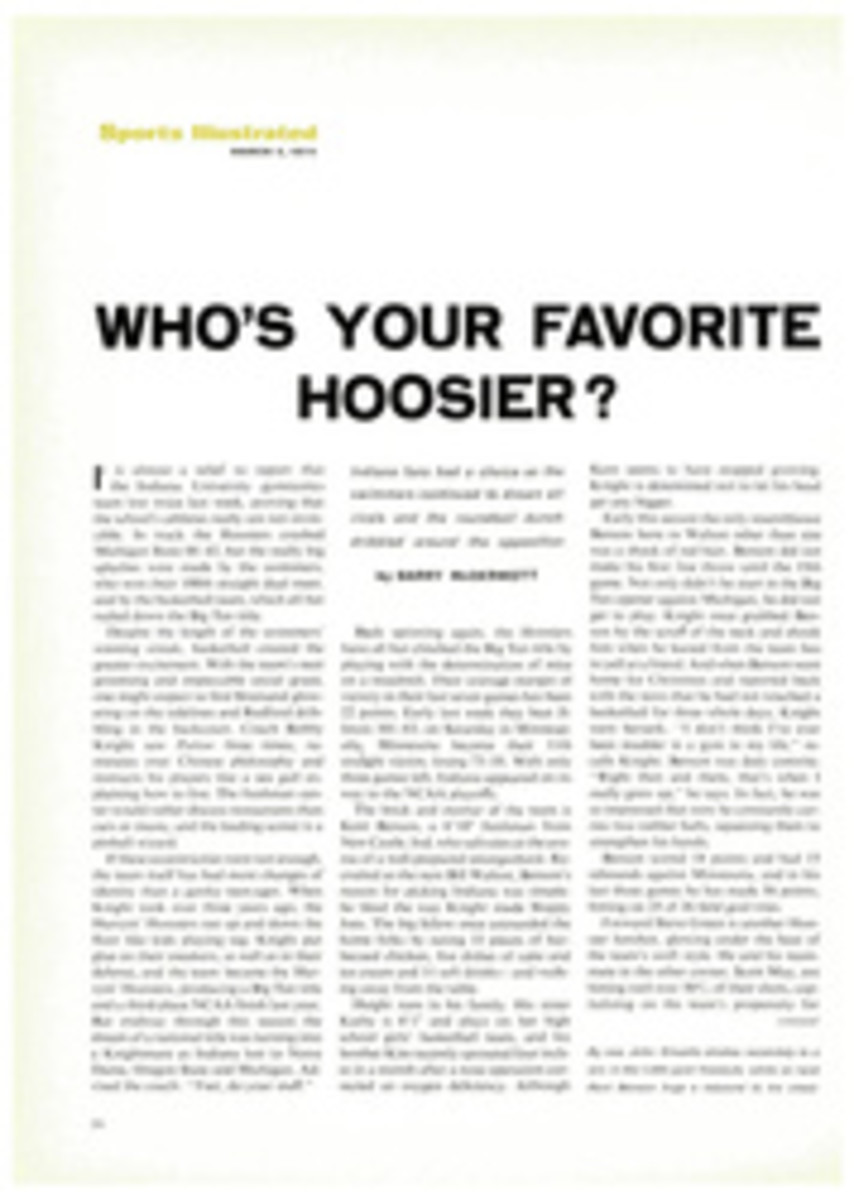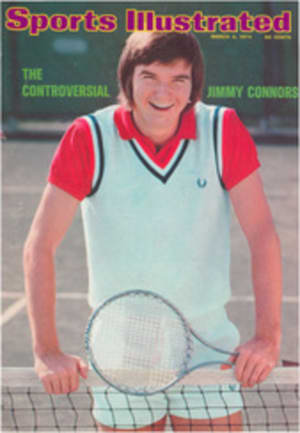
THAT OLD MAN RIVER OF GOLF
The pleasure of a buxom young golf tournament like last week's Jackie Gleason Inverrary is in the company it makes. The tournament, which ushers in the Florida portion—Phase II—of the pro tour, burst through the ropes two years ago with the noble intention of throwing prize money around in record amounts, an idea Gleason had while getting smashed one day and night in Jamaica, and in no time its irresistible swank has made the game come true for...well, for the girl in the red terry-cloth halter and plaid vinyl clogs who found the forced silence around the 15th green on Friday excruciating. "Golf is like television with the sound off," she whispered hoarsely.
And for the round-eyed blonde in the straw hat and banana-colored shorts whose boyfriend pointed out the legendary Sam Snead, way up the 11th fairway, informed her that Mr. Snead is now 61 years old, and, yes, sure enough, that was his ball skipping past them toward the green. The girl was properly amazed. "You mean he put it way up to here in one scoop?" she said.
Discovering Sam Snead is nothing new, of course; galleries have been agog over him for generations. And since Snead himself has always been a sucker for the cash-attracts gambit, it was not surprising to see him striding after a share of Inverrary's $260,000 pot, the second largest on the U.S. tour.
What is surprising is that Snead is not exactly acting the part of an old dog sniffing for leftovers. Slamming Sammy is up there snapping and slamming and, uh, scooping for the top money again. That treacherous little utensil that brings them all down eventually, the common putter, is no longer an alien in Sam's wondrous hands. He is putting with conviction, if not overwhelming confidence, and suddenly he is 31 again. Well, 41 again.
Snead did not win at Inverrary. Leonard Thompson did, picking up $52,000 for his first tour victory—while Snead finished 15th, fading slightly in the last two rounds when he was one over par. But until then he had put the fear of Sam in his younger, hairier adversaries, as he had the week before when he tied for second in the Los Angeles Open. Victory was on the tip of his blade then, and he made a bold run for it at Inverrary where he was only a stroke off the lead after 36.
Snead has won 84 tournaments in his career, more than anyone, but he has not won since the 1965 Greensboro Open when, at 52, he became the oldest player to win a regular tournament (not counting seniors events). At one point at Inverrary, late in the third round when he was in a dogfight—and loving it—with a large group of leaders, the combined years of experience of five of the players ahead of him, Thompson, Kermit Zarley, Bud Allin, Roy Pace and Hale Irwin, were fewer than his 37 in the service of his sport. In the last two tournaments, the L.A. Open and Inverrary, he has outshot Jack Nicklaus by 3 strokes, Lanny Wadkins by 5, Johnny Miller by 6 and the current heartthrob Ben Crenshaw by 19.
The classic shockproof, waterproof, 24-hour, self-winding Snead swing was still very much intact, as if its delicate mechanism were sealed in butter. There is none—not one—prettier on the tour, and though he has to get a little more belly out of the way to complete it there are many younger bellies more prominent than his. It is true that some of the slam is gone from Snead's game, too, but he has become what fellow pros call "sneaky long." "Just when you've been outhitting him all day," says one, "and you think he's on the ropes, wham, he sends one past you 20 yards. It can shake you up."
The better news is that Snead's putting has regained the flush of youth. Or at least a more glowing twilight. Everyone knows from all the funny pictures that Snead years ago adopted the so-called croquet style of putting. He had begun to "get the yips" over short putts, and his scores soared. But before he could master the action the USGA—which couldn't stand the sight of it either—outlawed the croquet and any stroke that involved "straddling the line."
Did that stop Sam? Does a vegetarian eat pork chops? He simply repositioned his right leg on the same side of the ball as the left and dropped into a position somewhat reminiscent of a man teetering on a skateboard. "Sidesaddle," Sam called it. That way he could still look directly at the hole and could grip the club the way a surveyor might, carrying through the stroke with his right hand, "like pitching pennies," he says.
Humbling himself in that manner "would never bother Sam," says Jack Tuthill of the PGA. "Hogan wouldn't have done it. Most great stylists probably wouldn't, not if they thought it would make them look bad. But Sam's a competitor. If he can't do it one way, he'll find another." The name of the game, says Snead, "is to get the ball in the hole and pick up the check. That's all."
Last December, right after the Disney World Classic, Snead told Tuthill that he had reached a point of progress where he thought he was putting "well enough to win." Before, he had been more or less satisfied to play with a hope of winning (he compared it with the chances of winning the Irish Sweepstakes). "But now he thinks he can win," says Tuthill. "That's the thing. So don't be surprised if he does."
In the second round at Inverrary he needed only 27 putts. One was a curling 25-footer for a birdie on the 18th, and the gallery—young and old ("I saw him play his first tournament," beamed one man)—exploded with appreciation, the sound striking the nearby tournament office with the impact of a mortar round. Sam said he hadn't had a better round of putting in years and that he had also "found something new"—that he could be even more effective if he gave his left hand more definition in the swing.
Snead began a rather slow fade in the third round. His putts were not so far off, but he missed three on the back side that were inside eight feet, and he kept achieving pars when birdies were needed. "I was too much on the defense," he said. "I'd been playing offense till then." He had said beforehand that the difference age had made was that he frequently got tired on the back nine; he was always a stronger finisher. But he added he was not tired now and wouldn't mind playing a few holes over again. Someone asked if it was all those young guys he was playing with that inspired him. "I inspire myself," Snead replied.
The stripped truth is that Sam Snead is a great athlete—not was, but is. At 61 he can still kick higher than the door, and there are clubhouse locker rooms around the country where the holes he put in the suspended ceilings have been left for posterity. "Sam Snead kicked that one out. Somebody bet him five bucks, and bam-o."
Stakes is the name of any game for Snead, but it is not true that he won't play for anything less than a $100 sure thing. He has been known to accept $2 Nassaus with total strangers ("I just ask 'em their handicaps and we go. I don't keep no books, you know what I mean?") and will give them his complete attention. In this light it is not hard for friends like Tuthill to fathom his longevity. He just loves to play, that's all. The Monday after a big tournament he is likely to be hanging around the clubhouse looking for a match. He will average as many as five or six rounds a week and says he once figured out that he went 13 years without missing a round of golf for more than two weeks at a time. He says if he didn't play so much his game "would shrivel up like a peach seed."
Unlike some of the well-spoken youngsters who assume the position that they go out only to "beat the course," Snead goes out to beat the guys. There is a definite man-to-man psychology in winning for Snead. Whether he still practices his once-famous gamesmanship is moot; it seems to depend on whom you talk to. On the 18th tee of the final round at Los Angeles he suddenly recalled for Dave Stockton that he had birdied these last two holes when he beat Hogan there in 1950. You are free to imagine the possible effect on Stockton's composure. (Boy. Two birdies. And he beat Hogan, too.) As it happened, Stockton still won the tournament.
It could have been only coincidental, also, when Snead stopped alongside tournament-leading Kermit Zarley on the practice tee at Inverrary and chirped, "There's old Moon Man [Zarley's nickname, given him by Bob Hope]. Let me look at old Moon and see why he's playing so well." (Imagine. Sam Snead is standing there, watching my swing. I wonder how it looks.)
Snead has been and remains a consistent and sometimes prickly breath of candor in a profession that breeds say-it-so-it-doesn't-sound-like-anything types. He is certainly not above zinging an opponent, or even an ally. "What's your handicap?" he will ask a pro-am partner. When told, he looks at his watch and says, "Well, I don't know if I've got that much time to play."
Most of Snead's adventures inevitably concern themselves with money ("you got to play for something, it's boring if you don't") and his ability to get most of yours and keep all of his. Close friends carry color pictures of Snead with his hand in their pockets. It is rather melancholy to recall, however, that Snead's heyday was at a time when rewards were skimpy. When he was the leading money winner in 1938 he made $19,534. When he led in 1949 he made $31,593 and in 1950 he topped the money list with $35,758. The most he ever made was $43,106 in 1968, his 32nd year on the tour. Last year he won $38,685.
But already this year he has won $18,100, so it is conceivable—even likely—that, at 61, in the bloom of veneration, he will break his own record for taking candy from the mouths of babes. If he says he can do it, who would doubt him? So, good for you, Sam, and take a couple scoops on us.
PHOTO
Snead first won in 1936, the last time in 1965, but he thinks that one more is still possible.

